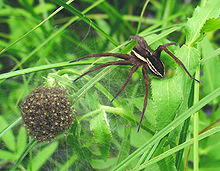
Dolomedes

Dolomedes /dɒləˈmiːdiːz/ is a genus of large spiders of the family Pisauridae. They are also known as fishing spiders, raft spiders, dock spiders or wharf spiders. Almost all Dolomedes species are semiaquatic, with the exception of the tree-dwelling D. albineus of the Southeastern United States. Many species have a striking pale stripe down each side of the body. They hunt by waiting at the edge of a pool or stream, then when they detect the ripples from prey, they run across the surface to subdue it using their foremost legs, which are tipped with small claws; like other spiders they then inject venom with their hollow jaws to kill and digest the prey. They mainly eat insects, but some larger species are able to catch small fish. They can also climb beneath the water, when they become encased in a silvery film of air. 'Dolomedes' is derived from the Greek word 'δολομήδης' which means wily, deceitful. There are over a hundred species of Dolomedes throughout the world; examples include Dolomedes aquaticus, a forest-stream species of New Zealand, the raft spider (D. fimbriatus), which lives in bogs in Europe, and the great raft spider (D. plantarius), which lives in fens, also in Europe. Many species are large, some with females up to 26 mm (1.0 in) long with a leg span of 80 mm (3.1 in). Dolomedes spiders are covered all over in short, velvety hairs which are unwettable (hydrophobic). This allows them to use surface tension to stand or run on the water, like pond skaters. They can also climb beneath the water, and then air becomes trapped in the body hairs and forms a thin film over the whole surface of the body and legs, giving them the appearance of fine polished silver. Like other spiders, Dolomedes breathe with book lungs beneath their abdomens, and these open into the air film, allowing the spiders to breathe while submerged. The trapped air makes them very buoyant and if they do not hold onto a rock or a plant stem they float to the surface where they pop onto the surface film, completely dry. Rather than hunting on land or by waiting in a web, these spiders hunt on the water surface itself, preying on mayflies, other aquatic insects, and even small fish. For fishing spiders, the water surface serves the same function as a web does for other spiders. They extend their legs onto the surface, feeling for vibrations given off by prey. Dolomedes are nocturnal hunters, feeding when birds, their main predators, are sleeping. The method they use to fish for insects is to hold on to the shore with their back legs while the rest of their body lies on the water, with legs stretched out. Dolomedes species tend to be robust with thickset legs that allow them to tackle prey larger than themselves. They stretch out their front legs and wait, as if listening. Their front legs feel the vibrations carried on the water, just as other spiders feel the vibrations in a web. They are able to tell what is causing the vibrations that the water is carrying - to distinguish the drawn-out, erratic vibrations of a struggling insect from the one-off vibrations caused by falling leaves or the background noise of the wind or the flow of the water around rocks and other obstacles. As well as identifying the source of the vibrations, the spiders are also able to discern the distance to and direction of the source. To this end they have a range of vibration-detecting organs, including very sensitive hairs (trichobothria) on their legs and feet. Their eyes play a secondary role - experiments on related species show that touch is the main sense these spiders use to catch their prey. Their eyes are of little use for nocturnal hunting. These vibration detectors also serve to warn the spider of predators such as trout. As soon as the vibrations reveal that there is a floundering insect within range, some fishing spiders may take direct action - they run at pace across the surface of the water and grab the insect before it extracts itself from the water and flies to safety. Some fishing spiders use silk draglines to prevent themselves from speeding past the prey. Fishing spiders' main prey is aquatic insects, but they are opportunistic feeders and will eat anything suitable that happens within range. Dolomedes in North America have been observed catching and eating small goldfish.
